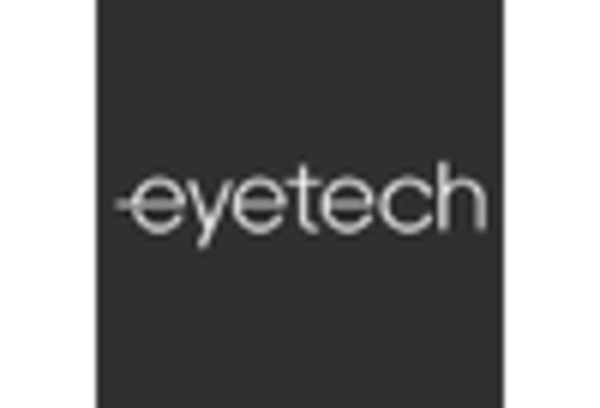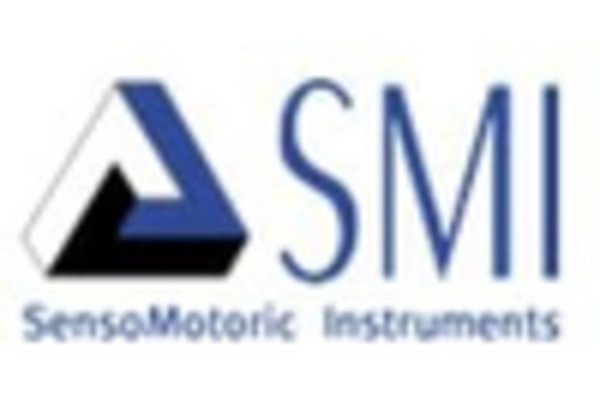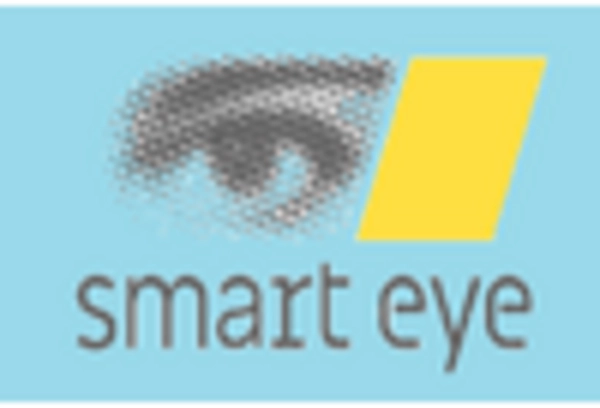Market Analysis
Eye Tracking Market (Global, 2024)
Introduction
Eye-tracking technology is a developing market that is expected to witness significant developments in the coming years. Eye-tracking technology, which is used to measure eye position and movement, is finding wide-ranging applications in the fields of medicine, automobiles, gaming, and marketing. This new technology is not only used to enhance the user experience but also to study consumer behavior and preferences. As more industries become aware of the importance of understanding visual attention and engagement, the demand for eye-tracking solutions is expected to increase. Artificial intelligence and machine learning are also expected to open up new avenues of application for eye-tracking technology, thus further increasing the demand and investment in the market. These trends are expected to position eye-tracking as a critical area of investment for companies that want to make data-driven decisions and improve the user experience.
PESTLE Analysis
- Political
- Eye-tracking is influenced by political factors in 2024, such as government regulations on data privacy and the use of technology. The General Data Protection Regulation (GDPR) stipulates how personal data, including biometric data from eye-tracking devices, can be collected and used. To avoid hefty fines of up to €20 million or 4% of annual turnover, companies will have to spend about €150,000 a year on legal and compliance issues. Political stability in North America and Europe also creates a good environment for the development of eye-tracking, especially in the medical and marketing sectors.
- Economic
- In 2024, the market for eye tracking will be shaped by a rising trend in the spending of consumers on advanced technology. In the United States, the market for consumer electronics is expected to reach $ 1200 billion, with a significant portion of it being earmarked for innovation in the form of eye-tracking systems. The global spending on health care is expected to reach over $ 10 trillion, with a strong demand for eye-tracking applications in the field of medical diagnostics and rehabilitation. The employment situation will be affected by the expected growth in the economy. The technology industry is expected to create over 200 000 new jobs in the United States, which will further stimulate the market for eye-tracking solutions.
- Social
- In 2024, the public has become more aware of eye-tracking and is becoming more receptive to it. Surveys show that about 65% of people aged between 18 and 34 are familiar with eye-tracking, especially in connection with games and virtual reality. This shift in the age structure is important because the younger generation is more likely to adopt new technology, thereby increasing the demand for eye-tracking. Furthermore, the growth in remote working has led to a greater interest in eye-tracking as a means of increasing productivity and improving the user experience. By the end of 2024, about 30% of companies intend to integrate eye-tracking into their operations.
- Technological
- The market for eye-tracking is rapidly changing. The advent of eye-tracking systems with an accuracy rate of 95% has revolutionized the application of eye-tracking in various fields, such as gaming, medicine and the automobile industry. The eye-tracking industry has allocated an estimated $500 million to research and development in order to further increase the accuracy and utility of eye-tracking. Furthermore, the integration of artificial intelligence into eye-tracking is expected to increase the level of interactivity, and it is estimated that by 2024, eye-tracking with an artificial intelligence component will account for 40% of the market.
- Legal
- Legal factors will have a crucial influence on the eye-tracking market in 2024, especially the intellectual property rights and the data protection laws. In the United States, the Federal Trade Commission (FTC) has stepped up its scrutiny of companies that use biometric data, with more than 50 investigations launched in 2024 alone. To ensure compliance, companies have to deal with a complex legal framework, which can cost them up to $1 million in legal advice and changes to their business practices. In addition, the number of patents related to eye-tracking has increased, with more than 1,200 new patents registered in 2024. These new patents are a sign of the increasing competition in the industry and the need to protect intellectual property.
- Environmental
- In 2024, companies will be striving to adopt sustainable practices. The global electronics industry is under pressure to reduce the estimated 50 million tons of e-waste it produces every year. In response, manufacturers are introducing new materials and recycling programmes. By 2024, it’s expected that a quarter of new products will be made from sustainable sources. Also, the European Union has set a target of reducing the carbon footprint of its digital products by a fifth by 2030. So the industry will have to develop more sustainable eye-tracking solutions.
Porter's Five Forces
- Threat of New Entrants
- The Eye-Tracking Market in 2024 faces a moderate threat of new entrants. In spite of the increasing availability of the technology, the market is dominated by a number of companies with a large customer base and advanced technology, which can impede the entry of new competitors. Also, the high cost of R & D and compliance with regulatory standards are barriers to entry.
- Bargaining Power of Suppliers
- Suppliers in the eye-tracking market have low bargaining power, since they have access to a large number of suppliers for both components and technology. The market is characterized by a large number of suppliers offering similar products, which limits their ability to influence prices and conditions significantly. If necessary, companies can easily change suppliers.
- Bargaining Power of Buyers
- The bargaining power of the buyer in the Eye-Tracking market is high, because there are many options to choose from. With the increasing number of companies that offer Eye-Tracking solutions, the customer can negotiate better terms and conditions. The customer is also able to influence the market, as there are alternatives available.
- Threat of Substitutes
- The threat of competition in the eye-tracking market is moderate. There are several other ways to interact and collect data, such as gesture and voice recognition. But eye tracking offers unique advantages that are not easily duplicated. However, as technology advances, substitutes may become viable.
- Competitive Rivalry
- Competition in the Eye-Tracking Market is high, with many established players and new entrants vying for market share. Product differentiation is a major driver of competition, with companies constantly improving their offerings. As a result, competition is fierce, with price wars and aggressive marketing strategies common. Competition is also intense, resulting in a decline in profit margins and increased spending on research and development.
SWOT Analysis
Strengths
- Advanced technology enabling precise tracking and analysis of eye movements.
- Growing demand in various sectors such as healthcare, gaming, and marketing.
- Increased investment in research and development leading to innovative applications.
Weaknesses
- High cost of eye tracking devices may limit accessibility for smaller businesses.
- Technical challenges in ensuring accuracy and reliability across diverse environments.
- Limited consumer awareness and understanding of eye tracking technology.
Opportunities
- Expansion into emerging markets with increasing adoption of technology.
- Integration with artificial intelligence and machine learning for enhanced data analysis.
- Potential for new applications in virtual reality and augmented reality experiences.
Threats
- Intense competition from alternative technologies and solutions.
- Rapid technological advancements may lead to obsolescence of current products.
- Privacy concerns regarding data collection and user consent.
Summary
The Eye Tracking Market 2024 is characterized by its advanced technology and growing demand from different industries, which presents considerable opportunities for expansion and innovation. But to fully take advantage of the opportunities, it is necessary to overcome the high cost, technical limitations and concerns about privacy. The companies that successfully address these weaknesses and threats and use their strengths to take advantage of this developing market will be able to achieve success.















Leave a Comment